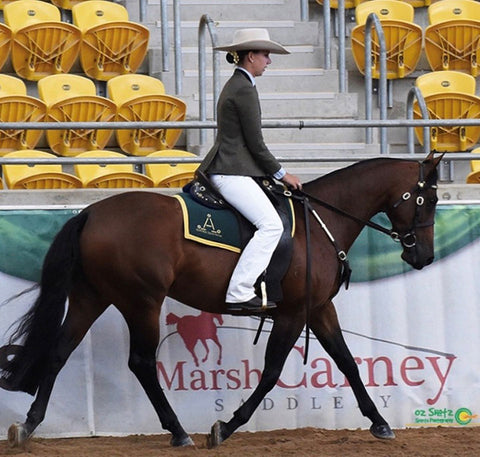FEEDING FOR A COOL, CALM HORSE
FEEDING FOR A COOL, CALM HORSE


FEEDING FOR A COOL, CALM HORSE
By Gail Sramek BAppSc (Agr) – Consulting Nutritionist to Mitavite®
01/03/2019
Fizzy or nervous behaviour by your horse can make a leisurely ride or performance, unpleasant and disappointing. Inexperience of the rider, excessive energy, a nervous make-up or a predisposition of a particular breed or bloodline can contribute to a horse being fizzy, unpredictable or anxious.
Patience, good handling, education and experience can often settle the fizzy, nervous horse. If an unbalanced, incorrectly fed diet has contributed to the fizzy nature of the horse then adjustments can be made.
One of the most important things we need to do when feeding a fizzy horse is to feed a balanced diet. It is important that we assess the two main components of the ration. The concentrate and the roughage.
CONSIDER FEEDING A CONCENTRATE
Feed moderate to low levels of starch
For a fizzy horse we don’t want to feed excess levels of starch. High starch meals can cause disproportionate exchanges in the blood glucose and insulin levels after feeding that contribute to highs and lows in energy utilisation. A high starch, low fibre ration may also be a contributing factor to digestive and metabolic disorders. We therefore want to feed a horse with a fizzy behaviour a ration that has a moderate to low starch level. This can be achieved by feeding a ration based on a feed such as Mitavite® Munga, which contains only 6% starch.
Match the energy level of the ration with the workload of the horse
The amount of energy fed in the ration should match the workload given to the horse each day. If the energy given is greater than workload then excessive weight and fizzy behaviour can occur. Have a look at Mitavite®'s exercise calculator to see what workload classification you should be matching your feeding regime with. This should only be used as a guide and the amount of concentrate fed will vary depending on the make-up of your horse.
Maximise digestion of nutrients in the small intestine
Feeding a more effective energy source that is primarily digested in the small intestine will lower the amount of heat, acid and gas produced by products in the large intestine that can contribute to fizzy behaviour. Steam-extruded or a combination of steam extruded and roasted and rolled feeds such as Xtra-Cool and Munga are ideal feeds for the fizzy horse.
Add cool energy sources if more condition or energy is needed
OILS - Oils are an excellent energy source for horses that have a fizzy disposition. Oils do not contain sugar or starch and are predominantly digested in the small intestine. It will provide more cover on your horse without the fizz. 50-200mls of Performa 3 Oil can be fed if more condition or cover is needed. This will provide the most favourable Omega 3: Omega 6 ratio.
ROUGHAGE
Don’t underestimate the importance of feeding roughage. Not feeding adequate levels of roughage can disrupt the balance of microbes in the hindgut. If the hindgut isn’t happy the caecum can become too acidic causing an imbalance that may contribute to fizzy behaviour.
When feeding any horse it is important to feed the correct levels of roughage…remember we don’t want the hindgut to become acidic. All horses need a minimum of 1-1.5% of their bodyweight of roughage in their diet per day. This could be pasture, hay, chaff and super fibres. If your horse is a good doer and you don’t need to feed high levels of concentrate you may need to feed more roughage to make sure your horse’s requirements are being met.
It is also important to feed the right ratio of roughage. We suggest approx. ¼ -1/3 lucerne and 2/3-3/4 grass or cereal roughage. Feeding too much lucerne may be a contributing factor to fizzy behaviour. Lucerne is very high in calcium and if lucerne is fed as the only roughage source it can impact on the calcium:magnesium and calcium:phosphorous ratio. This may impact on fizzy behaviour.
You may have heard of super fibres which have a low sugar and starch level and are really well digested in the hindgut, helping to keep the hindgut in the right balance. 0.5-1kg (wet down prior to feeding) can be fed in your horse’s ration to provide a well digested, cool, safe energy source to your horse.
SUPPLEMENTS
There is a range of supplements on the market making claim to quieten and calm horses. Remember when you are feeding supplements that you don’t want to upset the correct balance of nutrients. Too much of a nutrient can be just as bad as not feeding enough of a nutrient.
Armed with this information, hopefully your feeding regime will help your horse remain cool and calm. Now, how about that collection?


